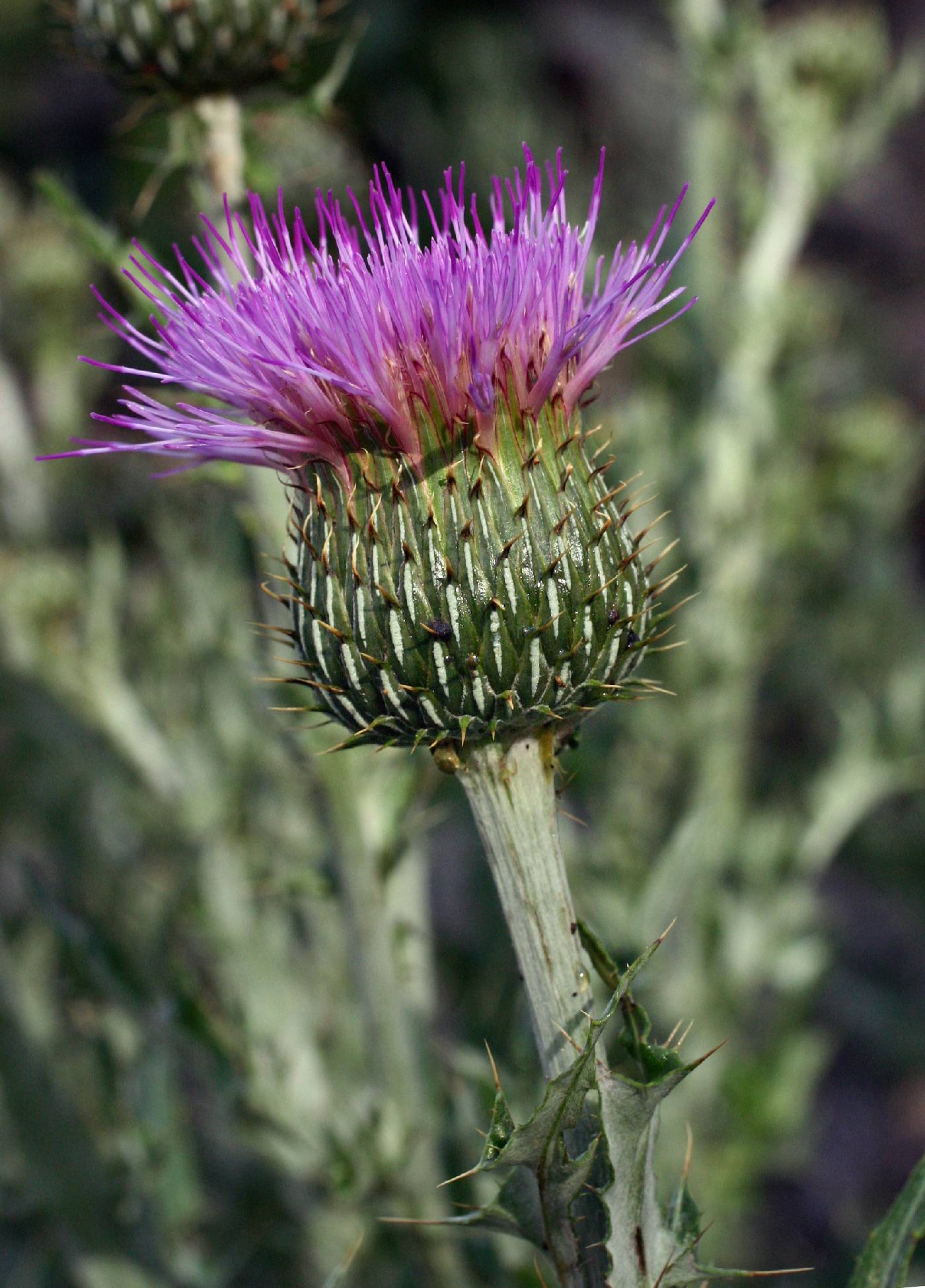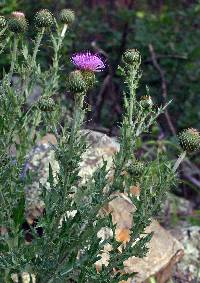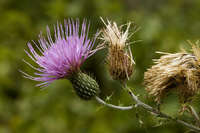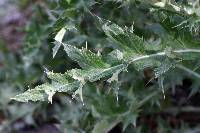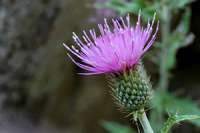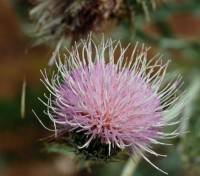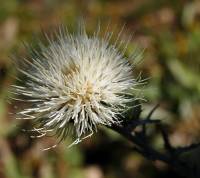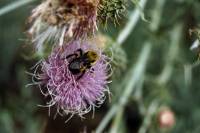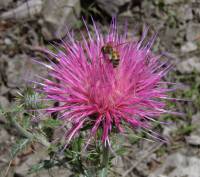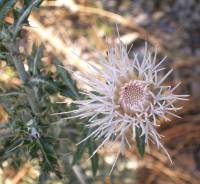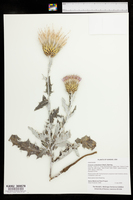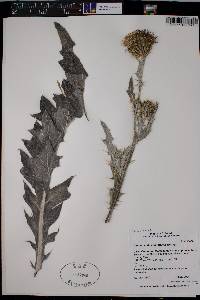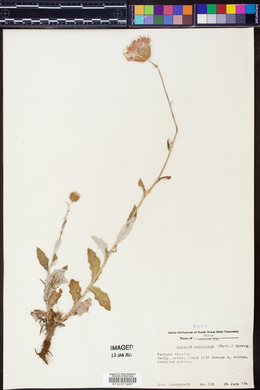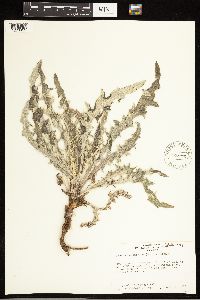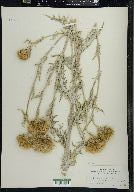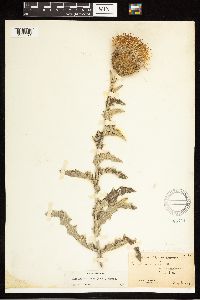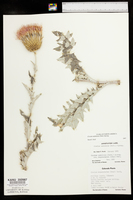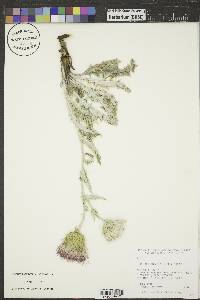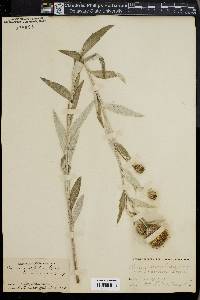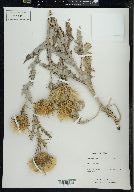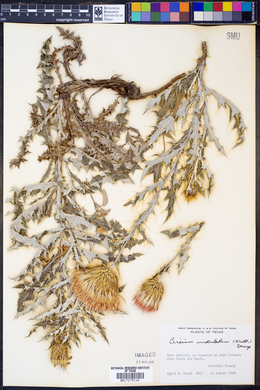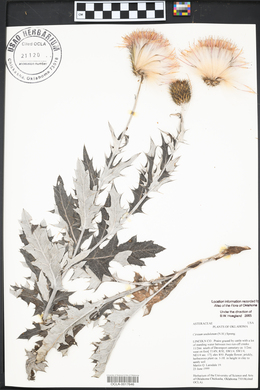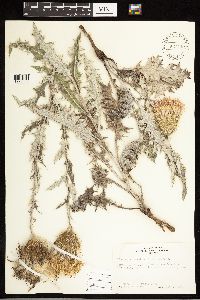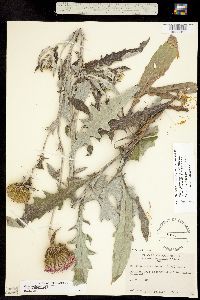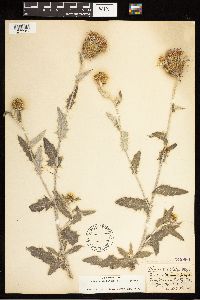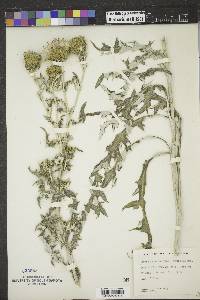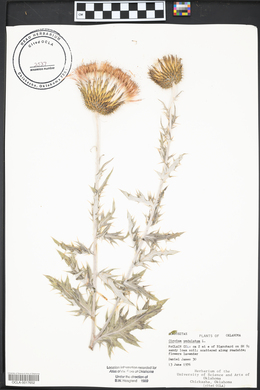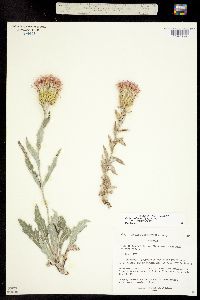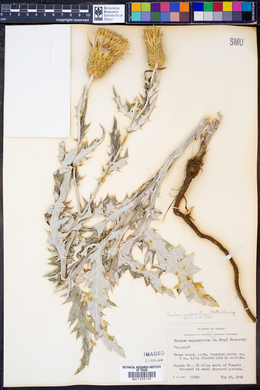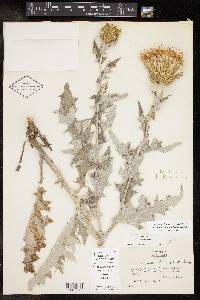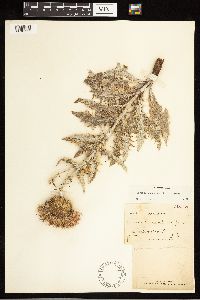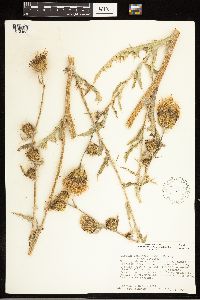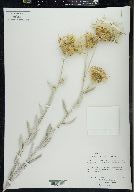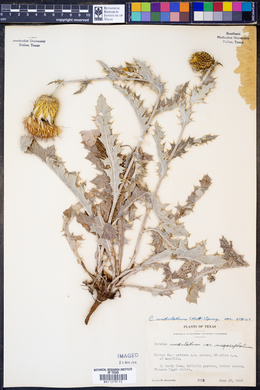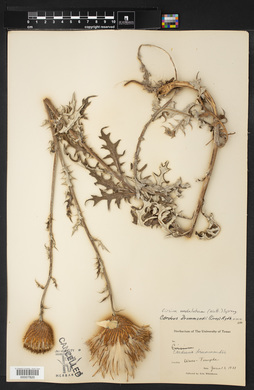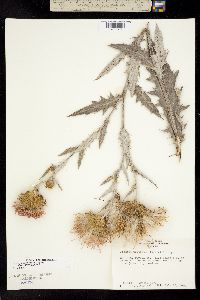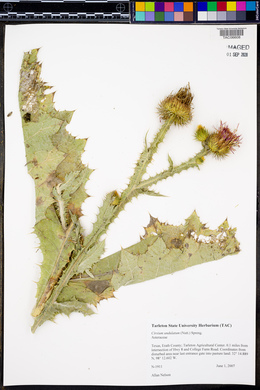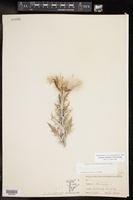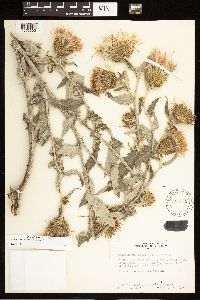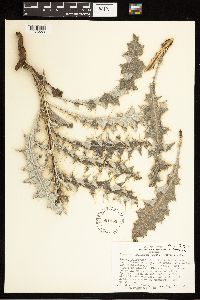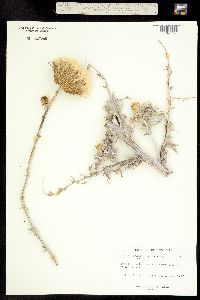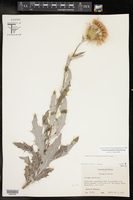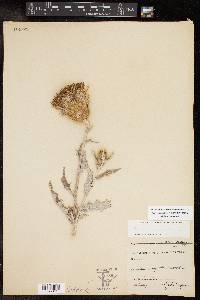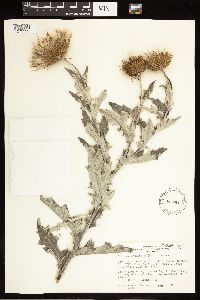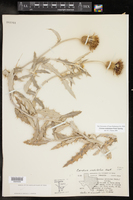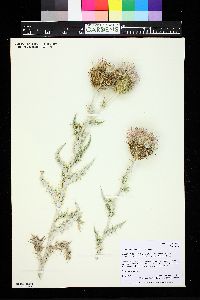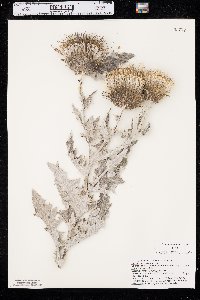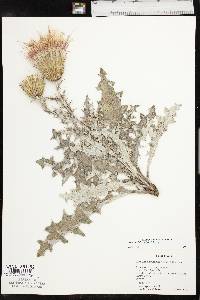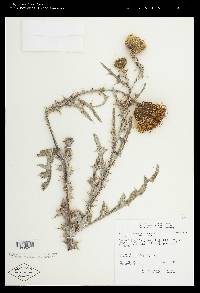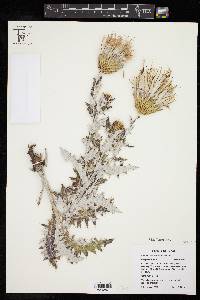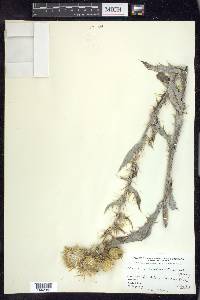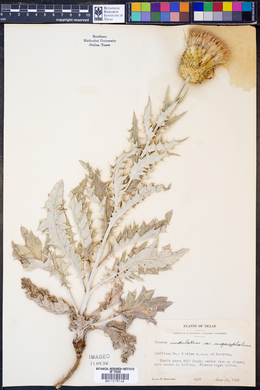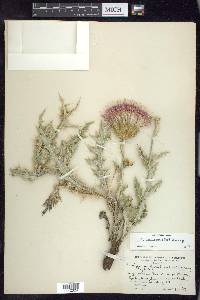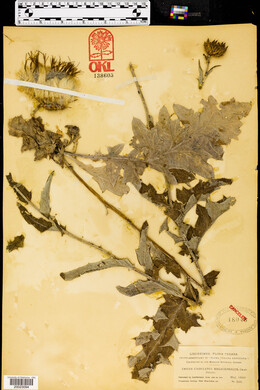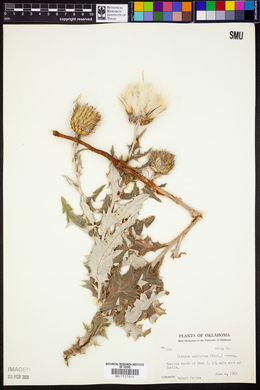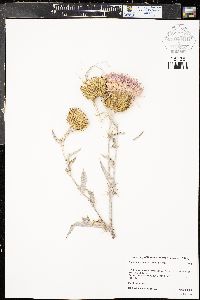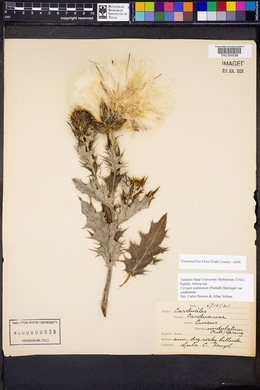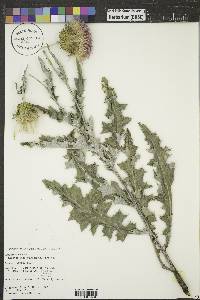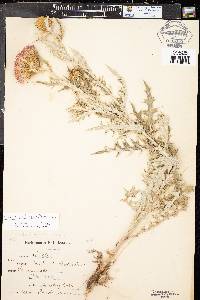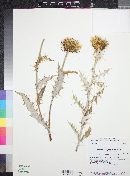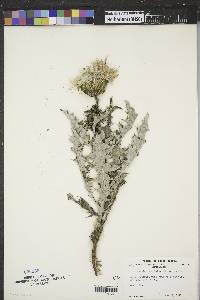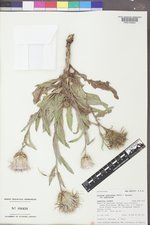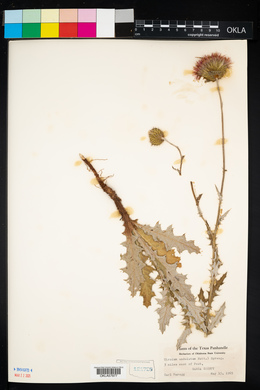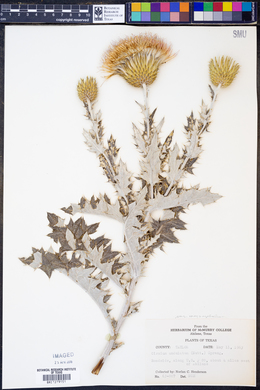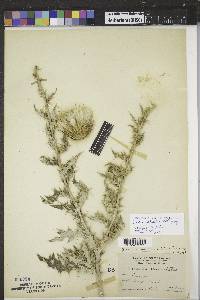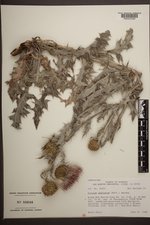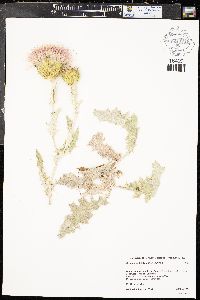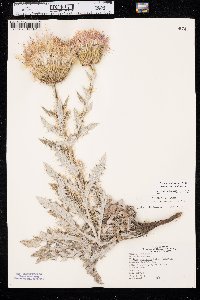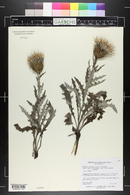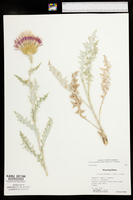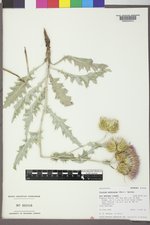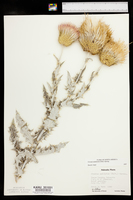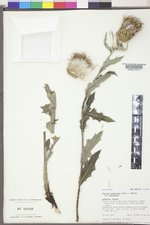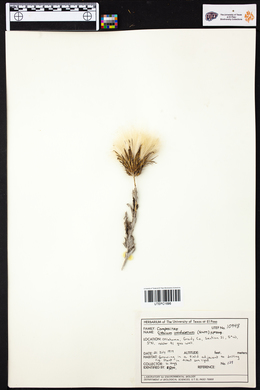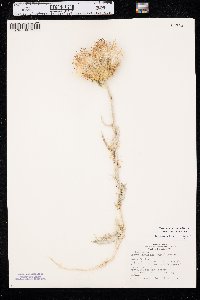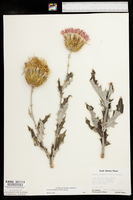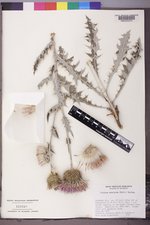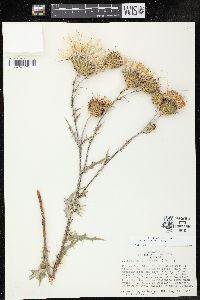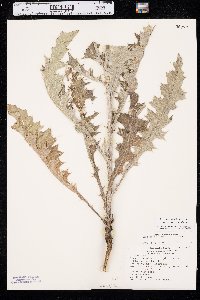
|
|
|
|
Family: Asteraceae
Wavy-Leaf Thistle, more... (es: cardo)
[Cirsium undulatum f. album Farw., moreCnicus undulatus (Nutt.) A.Gray] |
Perennials, 20-230 cm; deeply seated runner roots that produce adventitious buds. Stems 1-several, erect or ascending, densely gray-tomentose; branches 0-few, usually above middle, ascending. Leaves: blades elliptic to oblong or ovate, 10-40 × 1-10 cm, margins strongly undulate, coarsely dentate or shallowly to deeply lobed, lobes ascending to spreading, ± triangular, well separated to closely spaced, spinulose and coarsely dentate or usually cleft into 2-3 lanceolate to triangular, often entire-margined, spine-tipped divisions, main spines (yellowish), 2-12+ mm, abaxial densely gray-tomentose, adaxial faces thinly tomentose; basal sometimes present at flowering, winged-petiolate; principal cauline becoming sessile and progressively reduced distally, widest at base, bases ± auriculate-clasping to short-decurrent; distal reduced, spinier. Heads 1-10+, terminal on branches, in leafy, ± corymbiform arrays. Peduncles 0-25+ cm. Involucres ovoid to hemispheric or broadly campanulate, 2.5-4.5 × 1.5-4.5 cm, loosely arachnoid on phyllary margins or glabrate. Phyllaries in 8-12 series, imbricate, ovate to lanceolate (outer) to linear-lanceolate (inner), abaxial faces with prominent glutinous ridge; outer and middle appressed, spines spreading, 1.5-5 mm; apices of inner narrow, often flexuous, flat, ± entire, spineless or weakly spiny. Corollas lavender to pink, purple, or white, 24-50 mm, tubes 12-28 mm, throats 6-14 mm, lobes 6.5-13 mm; style tips 5-7.5 mm. Cypselae light to dark brown, 6-7 mm, bodies and apical collars concolorous, narrow; pappi 20-38 mm (usually scabridulous). 2n = 26. Flowering spring-autumn (May-Oct). Mixedgrass prairie, shortgrass prairie, Palouse prairie, sagebrush deserts, pinyon-juniper woodlands, openings in montane coniferous forests, often in disturbed areas; 100-2800 m; Alta., B.C., Man., Sask.; Ariz., Calif., Colo., Ga., Idaho, Ill., Ind., Iowa, Kans. Mich., Minn., Mo., Mont., Nebr., N.Mex., N.Dak., Okla., Oreg., Pa., S.Dak., Tex., Utah, Wash., Wis., Wyo.; Mexico (Chihuahua, Coahuila, Durango, Sonora). Cirsium undulatum is widely distributed in the wstern half of North America from the dry plains and plateaus of the Pacific Northwest eastward across the Great Plains to Manitoba and the Dakotas and south to Texas, New Mexico, and northwestern Mexico. It occurs in scattered localities in the Rocky Mountains and northeastern Great Basin region. At least some of the few widely scattered records from the eastern United States are probably introductions. Cirsium undulatum is both widespread and variable. Plants of the Great Plains region tend to be low-growing with a few large heads and elongate corollas. Plants of the Pacific Northwest are usually taller and produce smaller, more numerous heads with shorter corollas. A detailed study of this species might reveal races worthy of recognition as infraspecific taxa. Wavyleaf thistle is listed by California as a noxious weed. However, most reports of Cirsium undulatum in California are based upon misidentifications of C. canescens. Cirsium undulatum is known to hybridize with C. flodmanii, C. hookerianum, and C. scariosum var. coloradense. J. T. Howell (1960b) reported that C. undulatum was suspected to hybridize with C. brevifolium in the Pacific Northwest.
FNA 2006, Kearney and Peebles 1969, McDougall 1973, Heil et al 2013 Duration: Perennial Nativity: Native Lifeform: Forb/Herb General: Biennial or perennial herbs, 10-80 (200) cm tall, from well-developed rhizomes; stems densely gray-tomentose, erect or ascending, simple or branched sparingly above the middle; branches ascending. Leaves: Basal leaves on winged petioles, often early-withering; cauline leaves alternate, progressively reduced distally, the bases auriculate-clasping to short-decurrent; blades oblong to lanceolate and sinuate-pinnatifid, the margins toothed or entire, with spines 2-6 mm long, the blade undersides white-tomentose, upper surfaces floccose-tomentose but still green. Flowers: Flower heads discoid, arranged in clusters of 1-3 at branch tips; involucre (ring of bracts wrapped around flower head) ovoid to hemispheric or broadly campanulate, 2-5 cm high, the bracts (phyllaries) imbricate in 8-12 series, cobwebby on the margins but otherwise glabrous, with a prominent glutinous ridge on the back; outer phyllaries appressed and tipped with spreading spines, the spines 2-5 mm long; inner phyllaries twisted and erose at the apex, spineless or weakly spiny; florets all discs, the corollas 2-5 cm long, purple, pink, or rarely yellowish-white. Fruits: Achenes 6-7 mm long, light to dark brown, topped with a pappus of lightly scabrous bristles, 2-4 cm long. Ecology: Found in grasslands, desertscrub, sagebrush shrublands, and openings in montaine forests and woodlands, often in disturbed areas, from 4,500-9,500 ft (2134-2896 m); flowers June-October. Distribution: MI to British Columbia, south to TX, NM, AZ and CA. Notes: The keys to this species are the rosy-purple or rarely yellowish-white corollas, the heads in groups of 1-3; the phyllaries lance-ovate or oblong with a glutinous stripe down the back; the outer phyllaries appressed with short (2-5 mm) spreading spines on the tips; the inner phyllaries dilated and twisted, with erose (irregularly toothed) tips; and the stem leaves with auriculate or shortly decurrent bases. Ethnobotany: A decoction of the root was used to treat gonorrhea; used to make an eye wash; used to treat stomach ailments; used ceremonially as a life medicine; and the roots and stems were eaten. Etymology: Cirsium is Greek for thistle, while undulatum means wavy. Synonyms: Carduus undulatus, Cirsium megacephalum, C. undulatum var. megacephalum Editor: LCrumbacher 2011, AHazelton 2015 Stout, short-lived perennial from a taproot, this sometimes branching below-ground and producing more than one stem, but without the well developed creeping roots of no. 9 [Cirsium flodmanii (Rydb.) Arthur]; stem 3-12 dm, usually branched above, densely, closely and persistently white-tomentose; lower lf-surfaces similarly tomentose, the upper surfaces more thinly so and sometimes eventually glabrate; lvs coarsely toothed to pinnatifid, the lobes ovate, deltoid, or occasionally oblong, seldom under 7 mm wide; heads mostly several or many, tending to be broadly and shallowly invaginated at the base; invol 2.5-4(-5) cm, its bracts with a glandular-glutinous dorsal ridge and commonly a little marginal tomentum, well imbricate, the inner with attenuate and often crisped tips, the others with spine-tip 3-5 mm; fls pink-purple, sometimes rather pale; achenes 4-7 mm, inconspicuously or not at all banded across the top, becoming mucilaginous when wet (unlike all related spp.); 2n=26. Hillsides, prairies, railroad-tracks, and other open places, in well drained soil; B.C. to Ariz., e. to s. Man., Minn., and Mo., and occasionally intr. eastward. June-Sept. (C. megacephalum) Gleason, Henry A. & Cronquist, Arthur J. 1991. Manual of vascular plants of northeastern United States and adjacent Canada. lxxv + 910 pp. ©The New York Botanical Garden. All rights reserved. Used by permission. |
|
|
|
This project was made possible in part by the Institute of Museum and Library Services [MG-70-19-0057-19].
Powered by Symbiota

